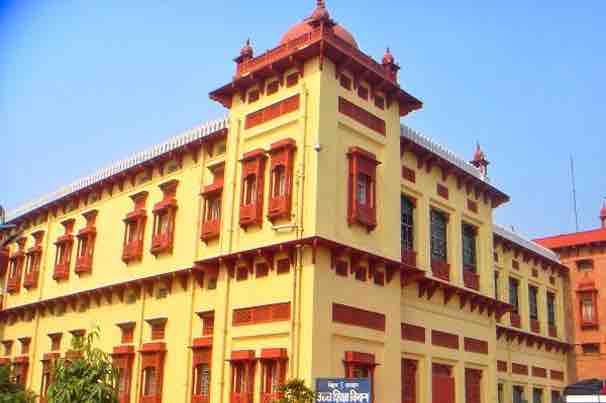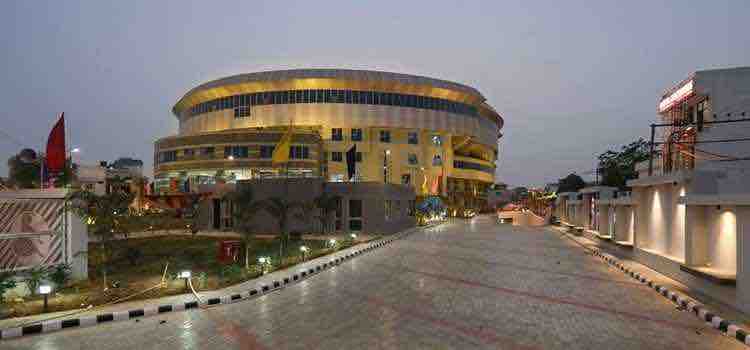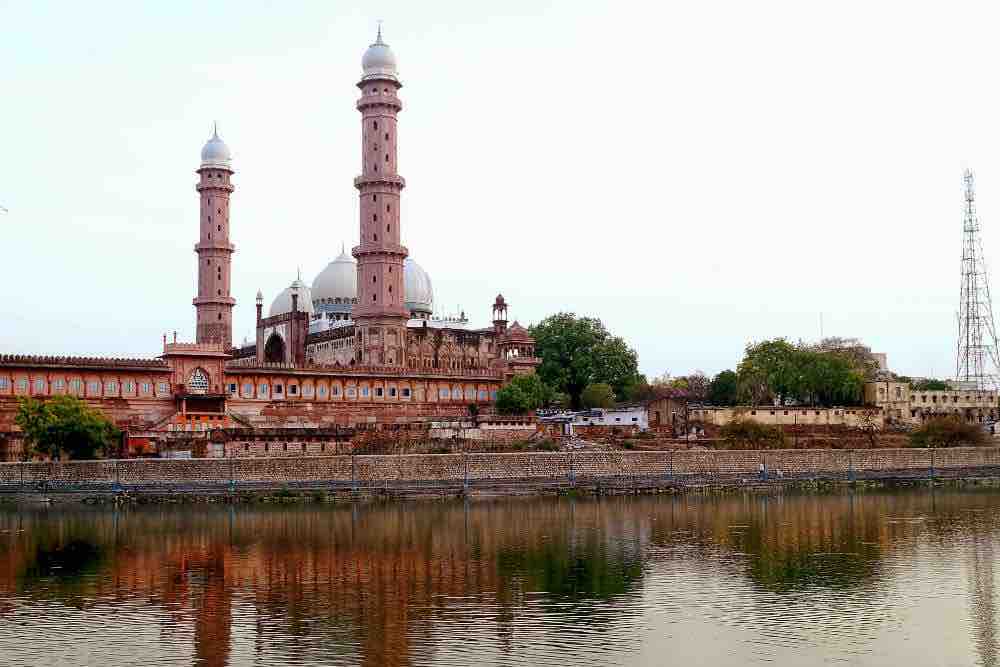Also known as the “The Blue City”, “Sun City” and “Gateway to Thar”, Jodhpur is famous for its Mehrangarh fort, blue houses, temples, sweets and snacks. Apart from the fort, there are multiple temples, lakes, shopping streets that are like a mirage from a bygone era.
The former capital of Marwar, Jodhpur is one of the most enchanting cities of Rajasthan, with its mighty Mehrangarh fort overlooking the city. The city is called the Blue City as it looks completely blue in colour from an aerial view because of its blue walls and blue houses. Nearby Jaswant Tada and Umaid Bhawan Palace are also among the top attractions in Jodhpur. However, the magic lies in the old city itself with hundreds of shops, guesthouses, eating joints and vendors make it a chirpy bustling city, especially near the landmark clock tower and Sardar Market.
Seen in the backdrop of the movie, The Dark Knight Rises, Jodhpur attracts hundreds of thousands of visitors from all over the world. Jodhpur is conveniently located in the centre of Rajasthan making it easier for people visiting Jodhpur to explore other destinations of the state.
Places to Visit
Mehrangarh Fort
Mehrangarh, also known as Mehran Fort was built by Rao Jodha in 1459 in Jodhpur, is one of the largest forts in the country. It is situated at the top of a 410 feet elevated hill and guarded by massive walls. One of the most easily recognisable forts in Jodhpur, it has appeared in many Hollywood and Bollywood productions such as The Lion King, The Dark Knight Rises, and the more recent – Thugs of Hindostan. The entrance of the fort, atop a hill, is majestic and has seven gates. These are called Victory Gate, Fateh Gate, Gopal Gate, Bhairon Gate, Dedh Kamgra Gate, Marti Gate and finally Loha Gate. Each of these was built at different times and serves a very specific purpose. While one still has marks of cannon balls being hit on it, the other has spikes that can protect it from elephant and animal attacks. However, Victory Gate was built to commemorate the win of Maharaja Man Singh over Jaipur and Bikaner armies. The fort also has opulent palaces such as the Sheesh Mahal (Glass Palace) and Phool Mahal (Rose Palace).
The intricate carvings on the walls of the fort, the sprawling courtyards, its impressive history, striking palaces, museums and galleries allure tourists from all over the world. The fort also has one of the well-stocked museums of Rajasthan. There are six different galleries in the Mehrangarh Museum: Elephant’s howdahs, Palanquins, Daulat Khana, Armoury, Paintings and the Turban Gallery. National Geological Monument, Nagnecha Mataji Temple, Chamunda Temple and Rao Jodha Desert Rock Park are the tourist attractions in Mehrangarh Fort.
Jaswant Thada
In the royal state of Jodhpur lies Jaswant Thada, a splendid marble cenotaph monument that is also a mausoleum for the kings of Marwar. The memorial was built in the honour and memory of Maharaja Jaswant Singh II by his son Maharaja Sardar Singh in 1899 and is still used by the Marwar Royal Family as cremation grounds. The beautiful edifice is made out of intricately carved marble that is offset vibrantly against the red steps that lead up to the entrance. Jaswant Thada in Jodhpur is considered as an architectural landmark and must be seen by one and all. On the steps leading up to the monument, one can see local musicians and folk dancers entertain the visitors.
The cenotaph also has a beautifully maintained garden which the tourists can explore along with the monument. You can explore the intricate artistry on the carved marbles. The skilfully carved thin sheets of marble are worth appreciating. The entire structure resembles a temple with unmatched beauty. It is also called the Taj Mahal of Marwar and attracts tourists from all over the world.
Mandore Garden
Famous for its wide green expanses, exquisite architecture and royal cenotaphs, Mandore Garden of Jodhpur is indeed a sight to behold. Located just 9 kilometres away from Jodhpur; Mandore Garden is situated in Mandore which was once the ruling seat of the Pratihara dynasty. The garden is a part of the more massive Mehrangarh Fort, and also houses the famous Hall of Heroes and the temple of Three Hundred Million Gods. The garden also has a Government Museum, which is full of artefacts and old relics.
The most striking feature of the garden is the gorgeous cenotaphs or ‘dewals’ that can be found spread all across the Mandore Gardens. Undoubtedly, the most beautiful and famous of these cenotaphs is the one that belongs to Maharaja Ajit Singh. The structures inside the garden are undoubtedly its most striking feature, the Hall of Heroes for instance – has 16 figures of warriors carved from a single rock.
Umaid Bhawan Palace
Built in 1943, Umaid Bhavan Palace in Jodhpur is a wonderful amalgamation of a fascinating past and a luxurious present. It is, at the same time – a heritage hotel, a museum and the residence of the Royal Family of the present owner, Raja Gaj Singh. In addition to being a historical landmark, the palace was commissioned in 1929, was built in order to provide employment to the drought and grief-stricken farmers of the area and thus took longer to complete. Umaid Bhavan Palace offers amazing encounters ranging from heritage walks to unforgettable dining experiences. The award-winning hotel is well-known and loved for its hospitality and a feel of the luxurious living. It was recently in the news for being the site of the Bollywood Superstar Priyanka Chopra and Nick Jonas – a renowned Pop Star from the Band – One Direction.
At present, the 347 – room palace has been divided into three parts. One part is the residence of the royal family, where the tourists are not allowed to enter. The second houses a museum which displays a rich collection of photographs, arms, clocks, stuffed animals and many other possessions of the royal family. The third part of the palace has been converted into a five-star hotel and offers the most exquisite services to its clientele. It is one of the most popular hotels in Jodhpur. Perched atop the mighty Chittar Hill, this palace is often referred to as the Chittar Palace too. To add to the beauty of the palace, there is a beautiful garden outside with lush greenery and different varieties of flowers.
Flying Fox
The Flying Fox Zipline Tour in Jodhpur is arguably the most memorable way to experience the Mehrangarh Fort, a key attraction of the blue city. A stunning way to admire the stunning art, architecture, and colors of the city, Flying Fox in Jodhpur is a sport especially for all the adrenaline junkies that visit this historic city. A well-organised setup of six zip lines, this tour covers the walls, the bastions and the lakes of the fort, spanning an estimated time of two hours. Not only is it the best activity to get your heart racing, participants are also treated to a unique breathtaking collection of views of the picturesque city and the majestic fort.
For those apprehensive about adventure sports, the Flying Fox Asia takes utmost care in installing equipment with supreme standards of safety. The activity was started in 2010 and has had over 50,000 satisfied participants. The organisation also makes arrangements for the differently abled. The activity, however, is only open for participants above 10 years of age.
The activity begins with a short walk up the fort, followed by a safety brief and practice session before the actual zip lining begins. There are a total of six zip line over which the activity is conducted, each of which covers a different area. The six zip lines are Chokelao Challenge, Ranisar Rollercoaster, Chhota Wallah, Jai Jodha, Rajputs’ Revenge and The Magnificent Marwar, each an exhilarating experience by itself.
Ghanta Ghar
The Ghanta Ghar in Jodhpur is a magnificent clock tower in the centre of the city, built by Maharaja Sardar Singh about 200 years ago. Known as the clock tower of Rajasthan, it is a popular landmark that signifies the start of Old Jodhpur. The tower offers a brilliant panoramic view of the city from the top. The area surrounding this imposing structure is bustling with locals presenting all sorts of products and services, making it the busiest and largest marketplace of Jodhpur. The markets and the tower are a must visit for travellers who want to witness and experience the culture and people of Jodhpur.
The clock tower is surrounded by street markets, with the most famous amongst them being Sardar Market, named after the late king. One can find a variety of people in this locality, representing all walks of life. At night, the tower comes to life when it is all lit up, making for a glorious end to a day well spent at this bountiful market.
Toorji Ka Jhalra
Constructed in 1740, Toorji Ka Jhalra, commonly called stepwell of Jodhpur, is an intricate design of stepwell, one of the few remaining structures depicting the traditional water management systems of Jodhpur. This architectural wonder was built by the queen-consort of Maharaja Abhaya Singh, a sign of the age-old tradition of the region where royal women were in charge of overseeing the public water works. The design and structure help onlookers comprehend the lifestyle of the earlier generations who had used it in its prime, with the site serving as the local watering hole for its time.
This 250-year-old structure was made using the famous rose-red sandstone found in Jodhpur. More than 200 feet in depth, it was once adorned with intricate carvings of dancing elephants, medieval lions, cow waterspouts, and niches that showed various deities. There were two levels of access and a separate tank which were meant to receive water from the wheel system powered by the bullocks. Its impressive design attracts many tourists, and is regarded as a fun place by locals and visitors to engage in harmless, recreational water games in order to beat the heat.
Kaylana Lake
Located 8 km to the west of Jodhpur, the Kaylana Lake is a massive manmade lake, covering a surface of 84 square km. Constructed in 1872 by Pratap Singh, it serves as the primary resource for drinking water for the citizens of Jodhpur and other neighbouring settlements. A peaceful location, this lake is a must visit for most travellers who are road tripping between Jaisalmer and Jodhpur. It also serves as an excellent viewpoint for sunsets in Jodhpur.
The pristine lake is surrounded by Babul trees, hills, and rock formations, granting travellers many picturesque sights across its boundaries. A favourite among bird watchers, one can find a variety of bird species beating the heat of Rajasthan while enjoying the cool breeze of the lake. The Siberian Crane can also be spotted here during Winter. Visitors may avail boating services to truly explore the area or can have picnics by the lake if they are looking to relax in a serene and calm environment. Kaylana Lake is a great place to connect to various other tourist sites near Jodhpur, such as the Machia Biological Park, the Machiya Fort, and various Shiva temples. These sites are all within a 5 km radius of the outskirts of the lake.
Balsamand Lake
Famous for being the site of the Bal Samand Lake Palace, a heritage hotel, Balsamand Lake was built way back in 12th century. Located just 5km away from Jodhpur, it is a world away from the crowds and hustle of the city. The lake was created in 1159 AD by the Gurjara-Pratihara rulers to save the city of Jodhpur from droughts. The Maharaja Sur Singh, who was the creator of this artificial lake was honoured by the title of Sawai Raja in turn of his impeccable services. Surrounded by lush gardens, it contains a large variety of trees like mango, papaya, pomegranate, etc. Balsamand Palace, built in the 17th century on the lake, is a red sandstone architectural marvel which overlooks the lake.
The mesmerising lake was made famous by its adjoining estate is the summer home of the Jodhpur Maharajas. Not only does it offer a luxurious stay experience it also presents an idyllic location to enjoy sunset views and lakeside picnics. You can have long walks beside its water or have dinner as you sit at Balsamand Palace’s restaurant witnessing beautiful lake views. The entry to the lake is free of cost, however, getting to the gardens may cost a little, depending upon the season.
Umaid Heritage Art School
Situated in the heart of the city of Jodhpur, the Umaid Heritage Art School is an art gallery as well as an art school for the people wishing to see and learn the traditional artwork of Rajasthan. Many famous and budding artists are associated with this school, where one can learn and view painting, sketching, charcoal work, as well as the world famous Rajasthani miniature painting style. This school also offer short free lessons on traditional Rajasthani forms of painting for children and adults.
The Umaid Heritage School has been owned and managed for the past eleven years by Mr Vijay Raj, a great connoisseur of art and exceptionally talented in sketching, portrait making, and the miniature painting style of Rajasthan. The expertise of Gaurav Solanki, a renowned artist, specialised in the use of graphite and charcoal, are also found and shared here. Free miniature painting lessons are offered to all travellers, and artwork using oil, watercolour, graphite, charcoal, and many more mediums may be found and taught here.
Must Try Food in Jodhpur
1. Asian Fusion Restaurant On The Rocks
2. Rajasthani Restaurant Indique
3. Jhankar Choti Haveli Restaurant
4. Rajasthani Gypsy Dining Hall
5. Kalinga Restaurant
6. South Indian Restaurant Sankalp
7. Wonder View Roof Top Restaurant
8. Fusion Restaurant The Daily Grind
9. Janta Sweet Home
10. The Skyzz
How To Get Here
Jodhpur has a good connectivity by air, road and rail. Jodhpur has its own airport and railway station. Road connectivity is good too.
By Air
Jodhpur has a well-functioning airport with direct flights to Mumbai/Delhi/Ahmedabad and some other cities in Gujarat/Rajasthan. Flights could be a little expensive as there are just a few flights to here, but if you book in advance you should be able to get a good price.
By Road
Jodhpur has great road connectivity from other parts of the state. You can book sleeper bus tickets from Delhi or Ahmedabad – these typically have an overnight schedule and drop you in Jodhpur early morning. They are quite cheap and comfortable, and a good way to reach Jodhpur if you’re not able to get train tickets but want to do a budget trip.
By Train
Jodhpur railway station has good train connectivity with almost all the major cities in Rajasthan, and from Delhi/Mumbai/Ahmedabad and even Kolkata. From Delhi, taking a train is a very convenient option since you can take an overnight train to reach Jodhpur early morning. It takes a little long (around 16-18 hours) to reach from Mumbai. Jodhpur is well connected to Jaipur/Udaipur by train, so if you are planning a whole Rajasthan trip, traveling by train within Rajasthan is a good and cheap option.










